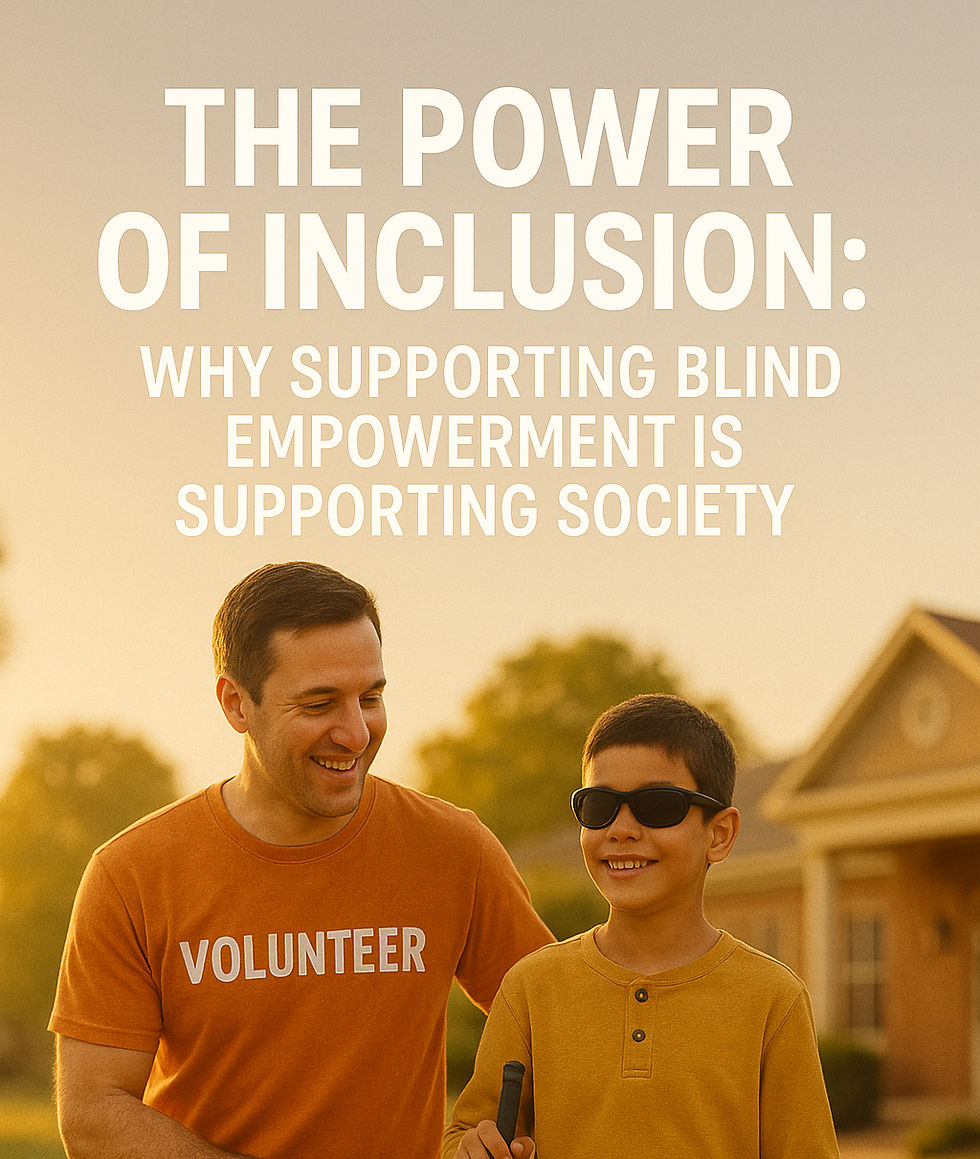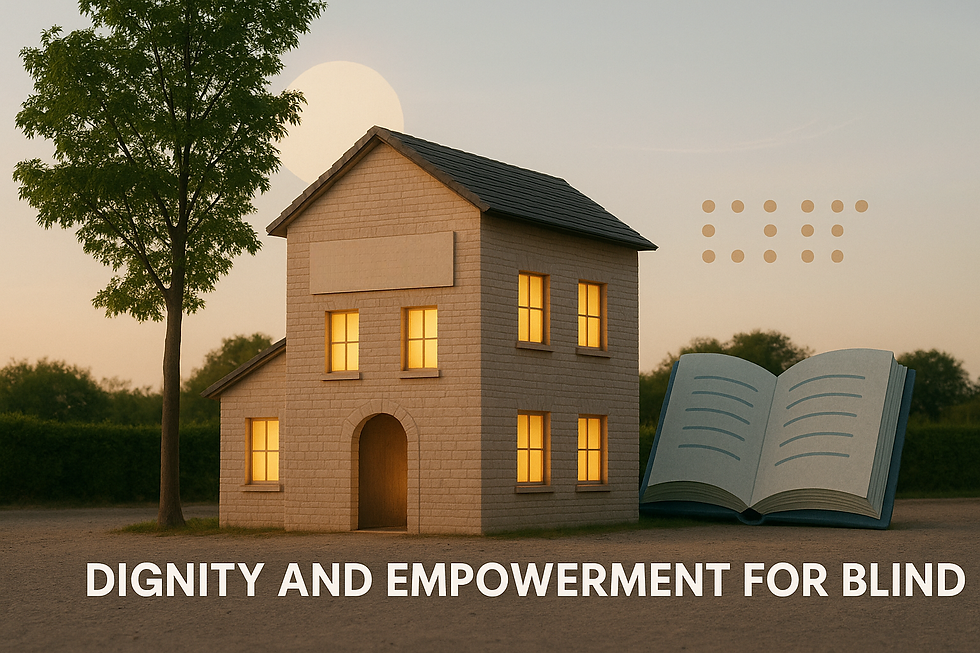The Power of Inclusion: Why Supporting Blind Empowerment is Supporting Society
- navjyotandhajan
- Apr 24
- 4 min read

Inclusion isn't just a buzzword. It's a movement, a mindset, and most importantly, a commitment to equity. It’s about ensuring that no one is left behind—not because of ability, appearance, or access. When we talk about the visually impaired, inclusion takes on a new dimension, where empathy meets action and charity becomes empowerment.
For decades, organizations like Navjyot Andhjan Mandal have been at the forefront of this silent revolution. Based in Gujarat, this remarkable institution is not just offering shelter or education—it’s shaping lives and reshaping societal mindsets. And in doing so, it's showing us a powerful truth: when you support blind empowerment, you're not just helping individuals—you’re uplifting the entire community.
Understanding Inclusion Beyond Accessibility
Inclusion often gets mistaken for accessibility. But the truth is, it goes far deeper.
It’s not just about installing tactile flooring, audio books, or writing signs in braille (though those are vital steps). Inclusion is about transforming perceptions—changing the way we talk about ability, the way we design opportunities, and the way we interact with one another.
It’s about seeing a visually impaired student as a future leader, not a charity case. It’s about creating classrooms and workplaces where differences are embraced rather than merely accommodated.
As shared by a teacher at Navjyot Andhjan Mandal:“Our goal isn't to make life easier for them—it’s to give them the tools to make life their own.”
The Ripple Effect of Empowering the Visually Impaired
Supporting blind empowerment is often seen as a selfless act. But its benefits stretch far beyond altruism. In fact, when you empower someone who is visually impaired, you start a chain reaction that enriches society as a whole.
In the Workforce
Inclusive workplaces tend to be more innovative and empathetic. Visually impaired individuals bring unique problem-solving skills, patience, and unmatched resilience. Companies that hire inclusively often report better team dynamics and deeper customer loyalty.
In Education
At Navjyot, visually impaired children are not just taught how to read or write—they’re taught to dream. With access to inclusive education, these children become empowered adults who can contribute meaningfully to society, reducing dependency and adding diversity to every field they enter.
In Daily Life
With empowerment comes independence. Whether it’s crossing the street with a white cane, managing finances, or cooking their own meals, these daily victories lead to bigger wins—confidence, self-worth, and dignity.
How Navjyot Andhjan Mandal Leads by Example
Navjyot Andhjan Mandal is more than just a safe haven. It’s a launchpad.
The organization offers a wide spectrum of services—residential education, mobility training, braille learning, computer literacy, vocational training, and cultural development. It’s a place where children learn how to use assistive technologies, express themselves through music and art, and prepare for real-world challenges.

But perhaps most importantly, Navjyot gives them a family—a community that believes in them even when the rest of the world can’t see their potential.
The transformation is not just visual—it’s spiritual. You see it in the way students walk, speak, and smile. You see it in the way volunteers and staff become lifelong supporters. You see it in the eyes of parents who once feared their child would be left behind.
Why Inclusion Benefits Everyone
We often think that inclusion benefits only the excluded. But in reality, it's a gift to all of us.
When we include the blind community, we’re teaching ourselves empathy, flexibility, and creativity. We learn to listen more carefully, to design more thoughtfully, and to value contributions we may have overlooked.
We create a culture where diversity is not a challenge but a strength. Where support systems are not just available but celebrated. And where the future belongs to everyone, not just a privileged few.
This is not just a vision—it’s a possibility. And it starts with recognizing that inclusion isn’t charity. It’s progress.
What You Can Do to Support the Movement
Inclusion isn’t only the responsibility of governments or nonprofits. It’s a collective effort. Here’s how you can be part of the change:
Learn and Share: Educate yourself and others about the realities of blindness and the power of inclusive practices.
Volunteer Your Time: Whether you're a student, working professional, or retiree, your skills can contribute to uplifting lives.
Adopt Inclusive Hiring: If you own a business or lead a team, create space for differently-abled individuals.
Support Financially: From sponsoring education to supporting vocational programs, your donations make a tangible difference.
Visit and Witness: Sometimes, seeing (or in this case, feeling) is believing. A visit to Navjyot Andhjan Mandal can leave you inspired in ways you never imagined.
You don’t need to search endlessly for the best NGO for blind donation—you’re already here, reading about one that has been changing lives with quiet consistency.
And in a world where quick searches like "food donation near me" lead to momentary help, consider offering support that builds a lifelong future.
Conclusion
We live in a world full of light—ideas, innovation, and infinite potential. But what if some of us are denied access to that light simply because they can’t see it?
Supporting blind empowerment is not about compensating for a disability—it’s about illuminating ability. It’s about creating a society that recognizes the value of every human being.
So the next time you think of help for blind people, remember this: You’re not just helping them—you’re enriching all of us.
Visit Navjyot Andhjan Mandal to witness hope in action. And if your heart moves you, consider lending your support—not out of sympathy, but out of belief in a better, more inclusive tomorrow.







Comments